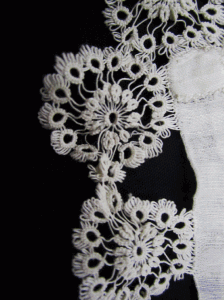Lace has been used to decorate and adorn for thousands of years. It has been found in ancient Egyptian tombs and still decorates clothing and objects in the world today. It was used by clergy of the early Catholic Church as part of vestments in religious ceremonies, but did not come into widespread use until the 16th century when the popularity of lace increased rapidly as did the cottage industry of making lace. Once the industry expanded, lace no longer was considered a luxury item. Lace suddenly became more affordable and easier to make. Women all over Europe, and eventually the world, were suddenly able to use lace in every day life. In the 19th century, lace making spread to the Native American tribes in North America through missionaries. St. John Francis Regis became the Patron Saint of Lace-Making, by helping girls establish lacemaking and embroidery trades to keep country girls away from the cities. On any given day you may observe lace on an individual’s clothing or possessions. Although women in Idaho do not have a vastly documented history of lace, women across Europe and North America used lace to accent, adorn, and enhance their status and personality and undoubtedly, Idaho women were no exception.
